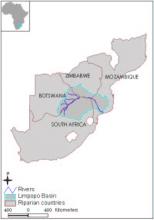Informations générale

Données de base
Varies from 290 mm/year to 1040 mm/year with a mean of 530 mm/year.
The irrigation potential in this basin is estimated at 295,000 ha of which 242,000 ha are presently irrigated.
Site Internet
Couverture géographique
This covers the Limpopo River and its tributaries of the Shashi and Elephant rivers.
| Pays | Superficie |
|---|---|
|
Botswana
|
81500km²
|
|
Mozambique
|
87200km²
|
|
Afrique du sud
|
183500km²
|
|
Zimbabwe
|
62600km²
|
Fonction/mandat
The objectives of LIMCOM are to advise the Contracting Parties and provide recommendations on the uses of the Limpopo, its tributaries, and its waters for purposes and measures of protection, preservation and management of the Limpopo. LIMCOM is a legal authority which advises the member states and provides recommendations on the uses, protection, preservation, and management of the Limpopo and its tributaries. The Council advises the Contracting Parties on the following matters, measures and arrangements to determine the long-term safe yield of water; the equitable and reasonable utilization of the Limpopo to support sustainable development in the territory of all member states; all aspects related to the efficient and effective collection, processing and dissemination of data and information and the development of contingency plans, investigations, and studies.
Fonctionnement
At the moment the Council which comprises of permanent members from member states is the only permanent structure. But other organs including a secretariat are planned.
The principal organ of the Limpopo Watercourse Commission (LIMCOM) is the Council, which consists of the member states’ delegations. Each government appoints three permanent members. Additionally, each delegation is allowed to be accompanied to the meetings by no more than three advisors. The Council can consult experts and establish working groups if necessary. The Council meets at least twice a year.
The Council advises the Contracting Parties on all aspects related to the efficient and effective collection, processing and dissemination of data and information with regard to the Limpopo.
Decisions are adopted on the basis of consensus as long as a quorum of three delegations is realized. In the case of a dispute the conflicting parties are required to enter into negotiations. If a solution cannot be reached within six months, the dispute can be referred to the SADC Tribunal unless the parties agree otherwise. Decisions of the Tribunal are final and binding.
Each member state covers the costs of its delegation. Meetings are financed by the hosting member state. All further costs or liabilities incurred by the Commission are equally covered by all member states.
Articles in the agreement require the Council to determine to what extent the inhabitants of the territory of each member state shall participate in the planning, utilization, sustainable development, protection, and conservation of the Limpopo.
Bases légales
| Date | Nom du traité | Signataires |
|---|---|---|
|
1983-02-17
|
Tripartite Committee Agreement
|
Mozambique
South Africa
Swaziland
|
|
2003-11-27
|
Formation of LIMCOM Agreement
|
Bostawana
Mozambique
South Africa
Zimbabwe
|
 AWIS/Sadieau
AWIS/Sadieau